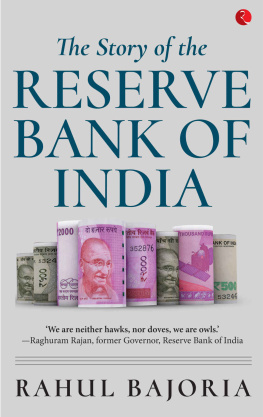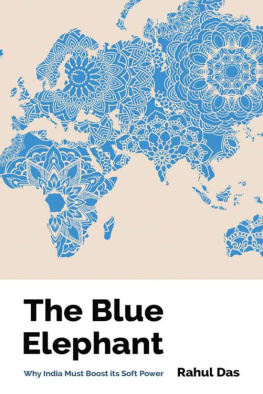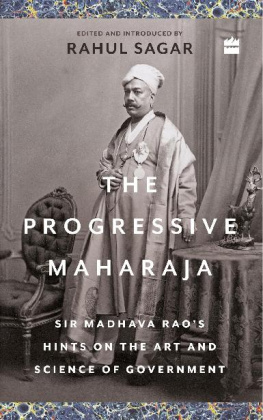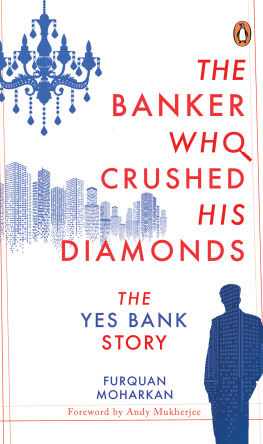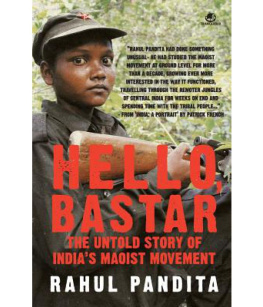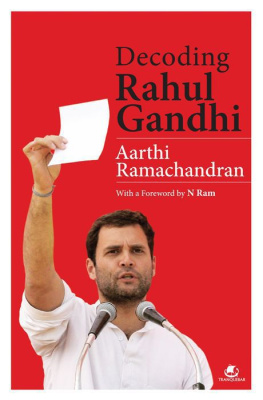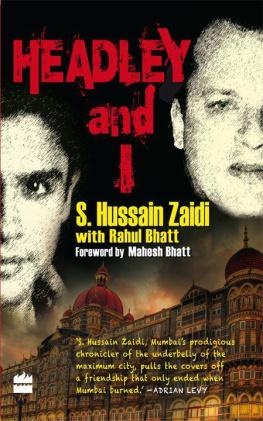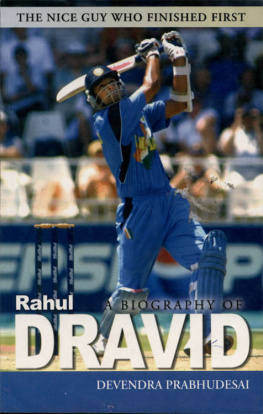Rahul Bajoria - The Story of the Reserve Bank of India
Here you can read online Rahul Bajoria - The Story of the Reserve Bank of India full text of the book (entire story) in english for free. Download pdf and epub, get meaning, cover and reviews about this ebook. year: 2018, genre: Politics. Description of the work, (preface) as well as reviews are available. Best literature library LitArk.com created for fans of good reading and offers a wide selection of genres:
Romance novel
Science fiction
Adventure
Detective
Science
History
Home and family
Prose
Art
Politics
Computer
Non-fiction
Religion
Business
Children
Humor
Choose a favorite category and find really read worthwhile books. Enjoy immersion in the world of imagination, feel the emotions of the characters or learn something new for yourself, make an fascinating discovery.
- Book:The Story of the Reserve Bank of India
- Author:
- Genre:
- Year:2018
- Rating:4 / 5
- Favourites:Add to favourites
- Your mark:
- 80
- 1
- 2
- 3
- 4
- 5
The Story of the Reserve Bank of India: summary, description and annotation
We offer to read an annotation, description, summary or preface (depends on what the author of the book "The Story of the Reserve Bank of India" wrote himself). If you haven't found the necessary information about the book — write in the comments, we will try to find it.
The Story of the Reserve Bank of India — read online for free the complete book (whole text) full work
Below is the text of the book, divided by pages. System saving the place of the last page read, allows you to conveniently read the book "The Story of the Reserve Bank of India" online for free, without having to search again every time where you left off. Put a bookmark, and you can go to the page where you finished reading at any time.
Font size:
Interval:
Bookmark:


Published by
Rupa Publications India Pvt. Ltd 2018
7/16, Ansari Road, Daryaganj
New Delhi 110002
Copyright Rahul Bajoria 2018
The views and opinions expressed in this book are the authors own and do not reflect the views of Barclays. The facts are as reported by the author which have been verified to the extent possible, and the publishers are not in any way liable for the same.
All rights reserved.
No part of this publication may be reproduced, transmitted, or stored in a retrieval system, in any form or by any means, electronic, mechanical, photocopying, recording or otherwise, without the prior permission of the publisher.
ISBN: 978-93-5304-644-6
First impression 2018
10 9 8 7 6 5 4 3 2 1
The moral right of the author has been asserted.
This book is sold subject to the condition that it shall not, by way of trade or otherwise, be lent, resold, hired out, or otherwise circulated, without the publishers prior consent, in any form of binding or cover other than that in which it is published.
To my parents
Contents
Introduction
More than a printing press
The government of India has very few islands of excellence. While Indias institutions have proved to be much more durable than those of its immediate neighbours, they nonetheless face similar issues of corruption, red tape and a general lack of competence. Despite Indias crippling governance issues, its financial sector and financial markets are open, deep and generally well regulated. This is somewhat of an anomaly, given Indias current level of development.
Since 2016, the role of the Reserve Bank of Indiathe RBIhas come under immense scrutiny, as it was a critical but perhaps unwilling participant in the governments November 2016 demonetization exercise. Political attacks on the institution, coupled with accusations of collusion, were made, but the staff of the Reserve Bank continued to do their job in a professional manner.
This was not the first demonetization that India had seen. It was also not the first time a large sum of the currency notes withdrawn from circulation returned to the banking system. Previously, in 1946 and then again in 1978, the Reserve Bank undertook similar exercises, but on a slightly smaller scale. The results were largely the same, with little money being extinguished from the system.
In the seventy years of Indias independent history, the Reserve Bank of India, an institution older than independent India itself, has played an important role in the nations economic development. The government has, to a large extent, left the RBI to emerge as an area of relative excellence, and technocrats have been allowed to design policies. The Reserve Bank has been an active participant in most areas, but the policies have often yielded mixed results.
Institutional autonomy vs individual independence
The role and the importance of the RBI increased substantially after 1991, as Indias economy opened up and its capital markets grew, perhaps much faster than what was warranted. As a regulator, RBI has had to not only intervene in areas that may be beyond its jurisdiction, but it has also been a key driver of introducing best practices in Indias financial markets, especially around bank regulation, minority investor protection and bond market regulation.
With the increase in its importance, the personalities running the bank have come into greater focus, which has sometimes led to clashes between the Reserve Bank and the government of India. The Ministry of Finance, which in a way is the parent institution to the Reserve Bank, has always treated the bank as somewhat of a problem child, with disagreements occurring on multiple occasions over a myriad of issues pertaining to Indias economic management. This was well summarized by former governor Raghuram Rajan, when he said, We (RBI) are the gatekeepers, and sometimes have to say no. This disavowal, however, was conspicuously absent during the recent demonetization exercise, which the Reserve Bank was widely criticized for, including by former governors.
Indeed, these personality clashes have often resulted in governors leaving their jobs before their terms expire. Most recently, the perceived clash between Raghuram Rajan and the government resulted in the popular governor not seeking another term, highlighting the fundamental difference in the policy objectives of the government on the one hand and the bank on the other.
Such clashes are not new, and they are a common feature of the modern financial system, where central banks occupy a unique position in every government around the world. Indeed, the very first governor of the RBI, Sir Osbourne Arkell Smith, an Australian, resigned due to his differences with the government on policy and personality issues. Similar issues cropped up between Governor Rama Rau and Finance Minister T.T. Krishnamachari, which resulted in a public altercation between the two in the corridors of the Secretariat buildings North Block in Delhi, culminating in the formers resignation in 1957.
As Governor H.V.R. Iyengar noted in the 1960s, the Reserve Bank was grappling with four key areas of conflict with the government, namely, interest rate policy, deficit financing, cooperative credit policies and management of sub-standard banks. These issues continue to manifest today, albeit in a slightly different form and spirit.
There are other instances that show at best a frosty relationship between the finance minister and the governor of the RBI. As Governor Y.V. Reddy once quipped, The Reserve Bank is independent within the boundaries set by the government. The clashes have become slightly more prominent with increasing media scrutiny, but also with the arrival of outsiders to the Reserve Bank itself. Indeed, Governor Rajan was already a reputed economist before his arrival in Indian policy circles, and Governor Urjit Patel has been a private sector economist for most of his career. Before them, the governors usually came from within the government, having served as career bureaucrats dealing with politicians and their agendas at close quarters.
The Ministry of Finance and its mandarins and the Reserve Bank have had different objectives over different periods of time, and it has not always been possible to reconcile them. In the corridors of power in Delhi, the Reserve Bank of India is often described as too conservative, a term often used by former employees of the central bank itself. This conservatism has generally served the country well, but has often led to allegations of the bank being behind the times and too tight-fisted.
Nonetheless, most governments have praised the Reserve Banks critical role in promoting financial inclusion and increasing savings, and have not tinkered around too much with its organizational set-up, thus creating conditions for the autonomous institution to flourish and fulfil its critical role in the government.
Gatekeeper of foreign capital, not policy manager
The word rupee comes from the Sanskrit word roopya, meaning shape or form. Used to denominate silver coins, rupee is used as a moniker for currency across South Asia and in Indonesia. Currency management, both operational and preserving its value, is a major task of any central bank. The RBI has also had the privilege of being the central banker to many countries, including Pakistan and Burma for short periods of time, along with managing currency systems in several Middle Eastern countries in its early years.
Modern currency management boils down to two primary objectives: ensuring that there is enough currency in circulation, and managing foreign reserves. With regard to foreign exchange, the Reserve Bank is responsible for managing it, not necessarily deciding on its direction. Unlike monetary policy, the sovereign largely controls foreign exchange policy, and hence the RBI does not necessarily control the direction of the currency. It uses tools such as direct currency intervention, its stock of foreign exchange reserves, and even the introduction of special windows and policies to manage the exchange rate.
Next pageFont size:
Interval:
Bookmark:
Similar books «The Story of the Reserve Bank of India»
Look at similar books to The Story of the Reserve Bank of India. We have selected literature similar in name and meaning in the hope of providing readers with more options to find new, interesting, not yet read works.
Discussion, reviews of the book The Story of the Reserve Bank of India and just readers' own opinions. Leave your comments, write what you think about the work, its meaning or the main characters. Specify what exactly you liked and what you didn't like, and why you think so.

